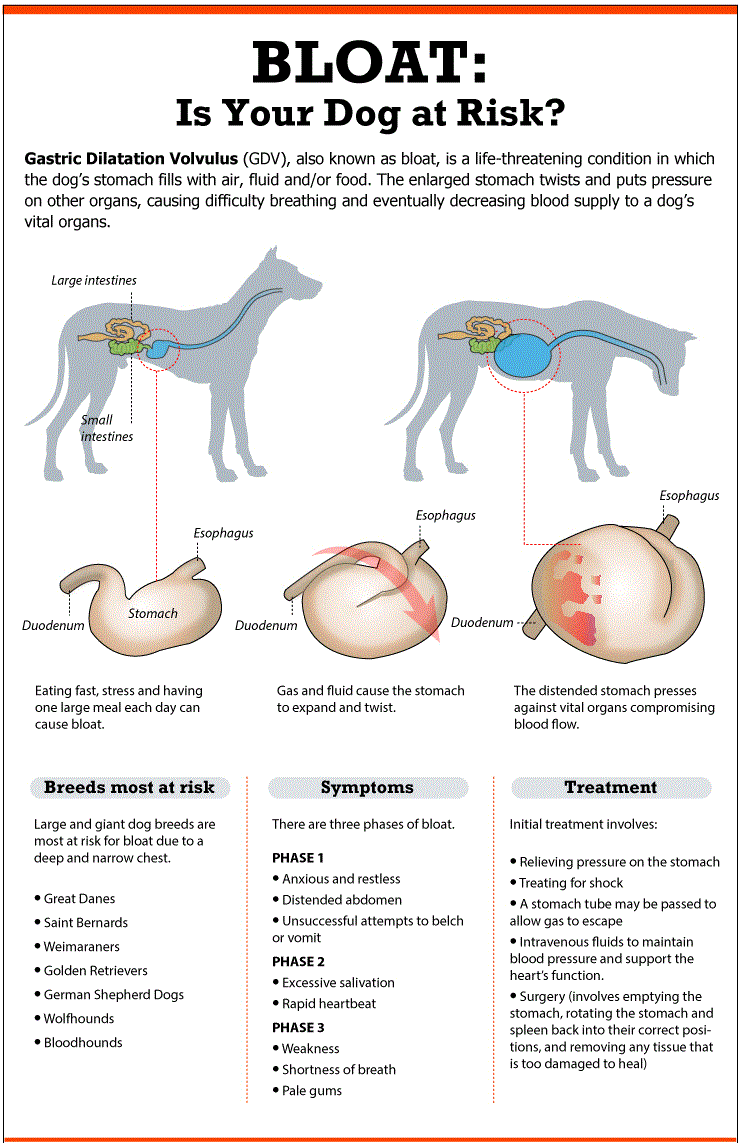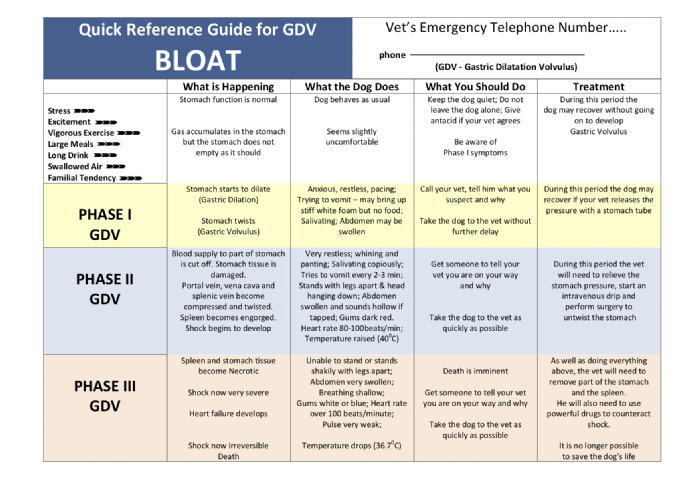Common Health Problems in Great Danes
Recommended Reading: The Australian Great Dane Health and Lifestyle Survey.
Bloat & Gastric Dilation-Volvulus (GDV)
Health is an area where being the biggest clearly isn't best. The Great Dane is prone to a condition known as "bloat and torsion" where the stomach twists on itself, trapping air inside. This is as grave an emergency as you'll ever face with your dog, and immediate surgery is the only thing that can save his life. The Internet is full of home remedies and suggestions for how to avoid that expensive trip to the emergency hospital. Ignore them and head for the veterinarian if you want to save your dog.
Before surgery, you can ask about having your dog's stomach tacked or “pexied”(gastropexy) which is a surgical operation in which the stomach is sutured to the abdominal wall or the diaphragm. This is a procedure that may prevent it from twisting again in the future. Nearly all dogs that bloat once will do so again and that surgery can save your dog's life. In fact, some Great Dane owners have it done routinely on all their dogs as a preventive measure.
GDV, often referred to as Bloat, is the number one killer of Danes, and they bloat more often than any other breed. In fact, they are 43.2 times more likely to be at risk of bloat compared to all other breeds according to a study done by the Department of Veterinary Preventive Medicine at the Ohio State University, and according to a JAVMA study reported in 2003, 5.3% of Great Danes exhibit GDV per year. This condition is known to be at least partly genetic, but there is no screening test for bloat at this time. Your puppy's breeder should be able to give you an idea of how many close relatives of his parents have bloated in the past; the fewer such animals in your puppy's ancestry, the better. See bottom of the page for further information and useful resources.
Dilated Cardiomyopathy (DCM)
Great Danes also suffer from a high incidence of cardiomyopathy, where the heart becomes enlarged. This is very common in all giant dogs, and when it occurs late in life, it is usually manageable with medication. Have your dog's heart checked at least once a year, and have any murmurs or unusual symptoms investigated by a board-certified veterinary cardiologist. This condition is genetic as well, but the testing currently available can only clear the dog for the time being; a dog could test clear one day and develop heart disease the next. DCM is characterised by the inability of the cardiac muscles to contract properly. Ultimately, that means that the amount of blood pumped by the heart is decreased, leading to poor circulation and secondary effects on the unaffected heart muscles.
Hyperthyroidism
Hypothyroidism is a very common endocrine disease in which normal thyroid hormone levels decrease. It happens either because of a progressive deficiency of thyroid hormone (usually due to autoimmune-related destruction of the thyroid gland known as “lymphocytic thyroiditis”) or because of a congenital disease process (one that’s present from birth).
Hypothyroidism in its non-congenital (acquired) form is the most commonly reported endocrine system problem in dogs. It happens when the thyroid gland atrophies (shrinks) as a result of a poorly understood auto-immune process, leading to a highly treatable disease state that affects multiple organ systems relatively mildly at first but invariably progresses in insidious ways. While a genetic predisposition has been proposed (and largely assumed) for the acquired version of hypothyroidism, for the congenital version of the disease a hereditary association is fairly obvious. This form of hypothyroidism, however, is considered very rare.
Cancer
Cancer is another leading cause of death in Great Danes, particularly lymphoma and bone cancer. They are also prone to a number of other skeletal, vision and neurological problems, both major and minor. Great Dane vet bills, like the dogs themselves, tend to be very, very large.
Anal Sacculitis (Impaction)
Anal sacs (also referred to as anal glands) are a pair of glands just under the skin adjacent to a dogs anus. The anal sacs fill with a foul-smelling fluid that’s normally expressed through tiny ducts during defecation. Though dogs have historically used their anal gland secretions to mark their territory, they often express these glands when they’re anxious or frightened.
Anal sacculitis is a term reserved for the frustrating condition characterised by the inflammation of these anal glands. Dogs so affected experience a build-up of fluid in their anal sac, an uncomfortable condition that can lead to pain and itching. Should this condition progress, the anal sacs can become infected or abscessed (filled with pus), usually only on one side. Anal sacculitis has been correlated with allergic skin disease, perianal fistulas, and gastrointestinal disease (especially with the production of poorly formed stool). Anal sacculitis is considered idiopathic, which is to say we don’t properly understand its cause.
Orthopaedic Conditions
Hip Dysplasia
Great Danes can also suffer from hip dysplasia, a crippling malformation of the hip socket that requires costly surgery to repair and that can result in painful arthritis later in life. Another genetic problem with an imperfect screening test, the best prevention for hip dysplasia at this time is to only buy a puppy whose parents both tested with normal or better hips and who have very few close relatives with the disease. Keeping your dog lean, particularly when he's young, can also help.
Hypertrophic Osteodystrophy (HOD)
Another painful bone condition is Hypertrophic Osteodystrophy, occurring during the rapid growth phase of puppyhood. According to a study reported in the Journal of the American Animal Hospital Association in 2002, Great Danes are 189.8 times more likely to be at risk for HOD than all other breeds.
Cervical Vertebral Instability (Wobblers)
Another breed-related condition affecting the Great Dane is cervical vertebral instability (CVI), commonly called Wobbler's syndrome. It's caused by a malformation of the vertebrae within the neck that results in pressure on the spinal cord and leads to weakness and lack of coordination in the hindquarters and sometimes to complete paralysis. Symptoms can be managed to a certain extent in dogs that are not severely affected, and some dogs experience some relief from surgery, but the outcome is far from certain. While CVI is thought to be genetic, there is no screening test for the condition.
Eye Conditions
Entropian
Entropion is a common disease of the eyelids in which the lower or upper lids roll inwards. This abnormal conformation of the eyelids is considered an undesirable inherited trait as it typically leads to pain and swelling of the eyes as a result of irritation caused by eyelash and other eyelid hair impingement on the cornea (the outer layer of the eyeball). Corneal ulcers are a common sequel of entropion and may lead to severe pain, vision impairment due to scarring and loss of the integrity of the entire eye, which can lead to enucleation (eyeball removal).
Distichiasis & Ectopic Cilia
Distichiasis (or Distichia) and Ectopic Cilia are considered relatively common inherited disorders of the canine eyelids in which abnormal hair growth occurs within the lids themselves. These hairs emerge from the openings of the oil glands present at the lid margins. They’re called “distichia” should they protrude onto the outer edge of the eyelid, and “ectopic cilia” if they grow inwards towards the eye.
Dogs affected with Distichia usually do not require any treatment, as the condition is mostly asymptomatic. Dogs affected with Ectopic Cilia, on the other hand, may experience extreme discomfort due to hairs rubbing on the delicate and nerve-rich cornea. Dogs with ectopic cilia typically present with uncomfortable eyes: tearing, blinking, redness and secondary conjunctival infections are common first signs. Later signs are consistent with corneal ulceration. Loss of vision due to corneal scarring and eye loss are likely if treatment isn’t sought. Almost all cases with ectopic cilia require treatment. By far the most recommended method used to treat both conditions involves a surgical procedure called “cryoepilation.” During this anesthetic procedure, abnormal hair follicles are frozen with a liquid nitrogen probe and the hairs are subsequently individually removed.

Contact Details
Please make contact with Club Secretary; Victoria Lansbury
- Post: PO Box 304, ROSEWOOD Q 4340
- Email: [email protected]

